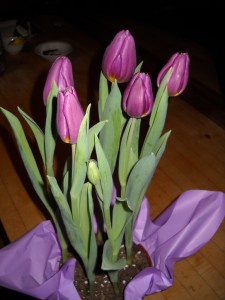Tulips
Winter is here and our flower gardens are, for the moment, just memories. But potted tulips in reds, purples and yellows are available at florist shops and grocery stores to brighten our spirits and grace our tables. For about $10 you, too, can have a few tulips in a 6-inch pot. If you keep them lightly watered and not too hot, they should last for at least a week.
On a recent rainy, slushy day I dug out a book on tulips that I’d been given years ago and never read, The Tulip by Anna Pavord. She is an excellent writer, but a bit obsessive when it comes to tulips. She follows the history of tulips in Europe from its origins in Turkey and Iran, describing in detail the kinds of tulips and who grew them. She even mentioned one sultan who had 920 gardeners!
The book continues through the tulip fads of Europe and the well known tulip craze in Holland when certain tulips sold at auction for the equivalent of 10 years income for a tradesman. I love tulips, but I’d certainly never be tempted to bet the ranch on being able to propagate and sell rare tulip bulbs. The Dutch particularly loved striped tulips. The best ones were actually created by a virus that was carried from plant to plant by aphids, causing some (but not all) to mutate.
The book has a nice summary of the kinds of tulips available: there are 15 “divisions” or groups of tulips, including the simple ones akin to the wild varieties originally from Persia or the East. It also has 50 pages of description of the common named varieties. This is truly a book for tulip-obsessive gardeners, and I admit I skipped over long sections of it. At 438 pages it would be a challenge for all but the most avid tulip lover to read in its entirety.
As I read through the descriptions of the divisions of tulips, I realized that I have at least tried growing of a few of each kind at some point in the past 30 years. I have settled into growing the tallest, most dramatic ones and treating them as annuals. My favorite is a creamy colored one called ‘Maureen’. I’ve read that it is a tetraploid, meaning that it has been somehow manipulated to have twice the number of genes as normal, so it grows bigger than most– 28 to 32 inches tall. This is not a GMO (genetically modified organism), but a hybrid developed in the 1950’s.
In my experience tulips run down hill with time: if I plant 100 bulbs in a cluster, as I like to, I expect to get 90 or more blossoms, come spring. But the second year I might get just 50, and half that the following year. So I re-plant in the same bed each year, and don’t worry about past year’s bulbs. After bloom season, I grow annual cutting flowers in that same bed, mainly zinnias.
Of the shorter tulips, I’ve found that the division called Kaufmanniana is very pleasing. These are short, stocky red tulips that are much more perennial than the big ones. The division called Greigii is another low, simple group. Those that I grew were yellow with stripes, and lasted several years before they disappeared. Tulip bulbs, as you may know, are attractive and tasty to rodents of all kinds and the stems and flowers have been providing lunch for deer forever.
My gardening grandfather, John Lenat (1885-1968) was a very friendly character, who spoke to everyone he met – in the line at the grocery store, at the bank or walking down the road. Along with a love for flowers and tomatoes, I inherited that – to my advantage. Many years ago I was standing in line at the local food Coop and, as Grampy would have done, I struck up a conversation with a woman who had selected some freshly cut tulips to buy.
That woman in line taught me a great trick. She explained that tulips can be persuaded to stay in bud rather than opening up (and soon dropping their petals) by dropping 3 pennies in the vase of water. Actually, this woman was someone who remembered WW II when, in 1943, pennies were made of steel and clad with zinc. So she said, “Drop three copper pennies in the vase.” Since I collected pennies as a boy, I knew about the zinc penny. But anyhow, I tried it, and it works! I don’t know what the copper does, but I’ve had tulips stay in bud for a week or more in the vase until they finally dropped their petals all at once.
Whether you are enjoying cut tulips or live tulips growing in a pot, keeping them cool always prolongs their bloom time. If you keep your house at 70 degrees, try to find a cooler location for them. Or put them in the fridge or in an unheated entryway at night.
Each fall I plant tulips in containers and store them in a cool dark place. Around the first of March I bring the tulips up to the warmth of the house and they soon blossom – long before my outdoor tulips.
So go buy some tulips. They’ll help you through the gloomy days of winter.
Henry Homeyer can be reached at PO Box 364, Cornish Flat, NH 03746 or on-line at henry.homeyer@comcast .net. His website is www.henryhomeyer.com.




